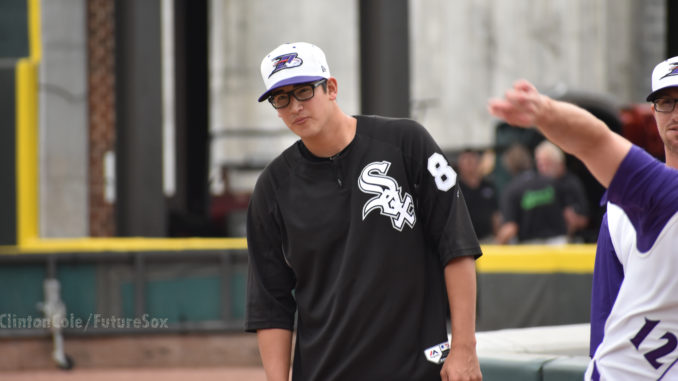
Rangers’ Current Situation
In my previous article, I looked at how the Rangers could make a few changes in the off-season (if you missed it, find it here). They have made the first few steps en route to doing so by naming ex-pitcher Chris Young as new GM, and now trading one of their biggest outlays in 2019, Lance Lynn. Lynn’s base salary came in at $10M, as well as his $1.33M signing bonus, and with a team that limped to a 22-38 finish, they looked to cash in and pick up a couple of young prospects from Chicago White Sox.
The Rangers’ Rotation
My previous article touched upon who could have been the starting pitchers for the Rangers in 2021. I looked at Gibson, Lyles, Hernandez, Palumbo, and Cody as the 5 starting pitchers. The acquisition of Dane Dunning, however, could change this slightly. In this article, I’ll take a more in-depth look into the Rangers’ new pitcher and what he may bring to this young team. He also came with another young pitcher, Avery Weems.
First up is the main one.
Dane Dunning
Breakdown
Drafted by the Washington Nationals in the 1st Round in 2016, Dunning was traded 6 months later to the White Sox. Himself, Lucas Giolito, and Reynaldo Lopez arrived in the deal for Adam Eaton. His first season in pro ball saw him make 26 appearances in 2017, mostly with Winston-Salem Dash in A+ (22), registering a season ERA of 2.94 with 168 Ks in 144 innings. This impressive pitching continued in 2018, as he made 15 appearances between A+ and AA, finishing with a 6-3 record and an ERA of 2.71.
However, problems started to arise at the back end of 2018 as he missed the final 2 months of the season with an elbow strain. He then missed the entirety of the 2019 season due to Tommy John Surgery. He did manage to return in 2020 and proved to be an effective part of the White Sox’s rotation.
Fastball
There are two types of fastball that Dunning currently possesses. His 4-seam fastball averages 92 mph and works all around the zone. The more effective of the two, his sinker, is a lot more consistent.
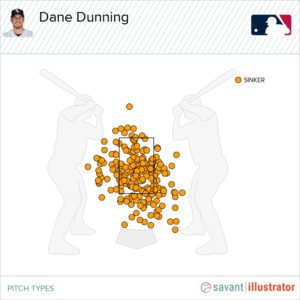
He used it 225 times in 2020, predominantly to right-handed batters. He worked around the strike zone but with more control and command than his 4-seam fastball.
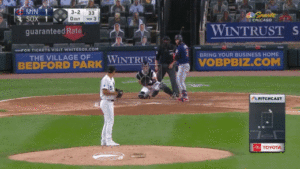
It has slightly less spin (2085) than his 4-seamer (2194), but hits the strike zone on a more consistent basis and picked up 10 of his 35 Ks. The velocity of his fastball isn’t big but it plays above the velocity due to its heavy sink and movement.
Secondaries
Dunning’s current secondaries consist of a slider, a curveball, and a changeup. Although there was a heavy reliance on his slider in 2020, his curveball seemed to be used less so, despite its effectiveness against left-handed batters.
Slider
He used his slider 124 times last season, picking up 17 Ks, in an impressive display against right-handed batters. He kept RHB to an average of just .135, despite allowing 3 HR. His pitch illustrator shows his heavy use towards the low and outer part of the zone, enticing batters to take wild swings at pitches.
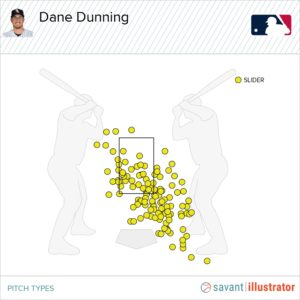
Overall he had a whiff of 43.5% against his sliders, with a launch angle of just 5. This shows his emphasis on keeping low in the zone and allowing the vertical movement and velocity to catch batters out.
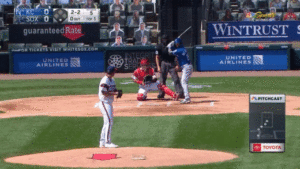
It turned out to be his go-to pitch when he wanted to put batters away, and he did so with aplomb.
Curveball
Surprisingly one of his lowest-used pitches, it was used just 39 times. There are thoughts that his CB surpasses his SL, but the more emphasis on using it against LHB shows that it could be an effective tool when doing so.
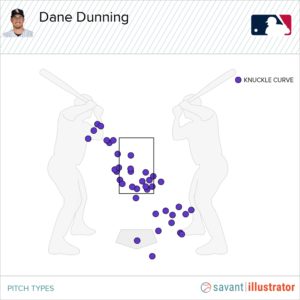
The pitch illustrator shows why he struggled to make a real impression with his CB in his first taste of the big leagues. There was minimal control over the pitch, and although there was plenty of vertical movement (62.6 inches), it didn’t have enough to be relied upon more often.
Changeup
The fourth and final pitch of his arsenal is his 85 mph changeup. There was a heavy reliance on this against LHB, and it picked up a couple of Ks as well.
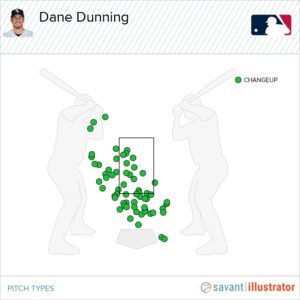
Focusing on the outer zones, the way he uses it alongside his 4-seamer creates a sense of deception due to the break of velocity. The slight decrease in spin rate doesn’t allow for a lot of movement but it has the potential to be a solid pitch with more work.
Generally, he has an impressive arsenal with the potential to get better as he gains more exposure to game time post-TJ Surgery. His standout pitch is his fastball, but the secondaries are very similar and each has its own use within his repertoire.
Use in 2021
Dunning should be used in the Majors as an SP4 in 2021. He fits in nicely with what the Rangers are trying to achieve. He has shown his potential as a middle-of-the-rotation pitcher with his comeback season last year, and his ability to manipulate his pitches in the right way.
Avery Weems
The other part of the trade that saw Dunning head to the Rangers was the addition of Avery Weems. The left-handed pitcher was drafted in the 6th Round of the 2019 Draft. He spent the 2019 season split between the Pioneer League and the Arizona League. He finished with a record of 5-4, and an ERA of 2.09. His 74 Ks in 60.1 innings shows his ability to pound the strike zone.
Summary
Looking at the trade from a Rangers’ perspective they have done well to get a good pitching prospect that has had some experience in the Majors. The White Sox would be happy that they managed to get Lance Lynn for a pitcher who recently recovered from TJ Surgery. All in all both teams will be happy with their returns and will be looking forward to two very different 2021 seasons.





Leave a Reply